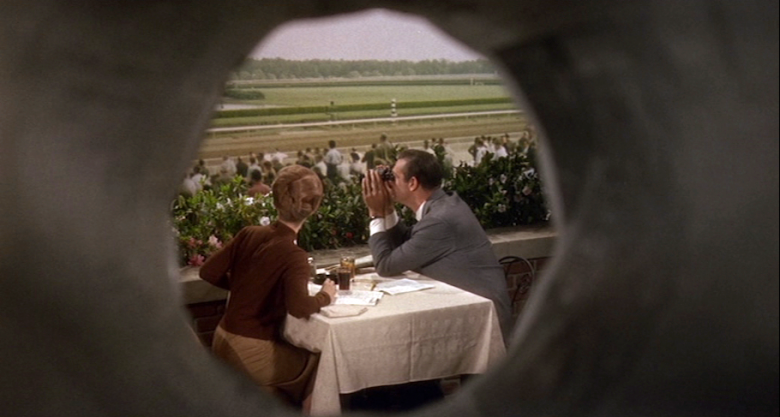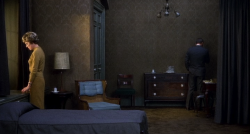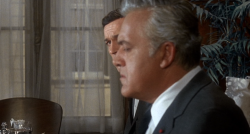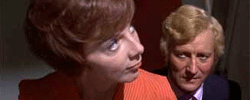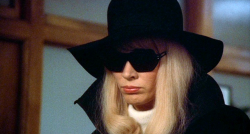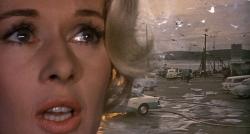Reviews
Alfred Hitchcock
USA, 1964
Credits
Review by Leo Goldsmith
Posted on 14 December 2011
Source Universal Studios DVD
Categories Late Hitchcock
By the late 1950s, Hitchcock’s thematic of the formation of the romantic couple had crystallized into two competing, even contrary forms. These polarities are clearly expressed, as Richard Allen has indicated in his book Hitchcock’s Romantic Irony, in films like North by Northwest and Vertigo, which deploy the whole of Hitchcock’s formal and stylistic arsenal to ensure contrary results. In the former film, the couple comes together almost magically despite double-crosses, attempted murder, and Cold War politics; in the latter, romantic unity is repeatedly and cruelly frustrated, conspiring to keep the hero and heroine (her chimerical false identity and her more earthbound true identity) hopelessly misaligned.
In the films that follow, Hitchcock continues to vary and manipulate these polarities, but in Marnie he seems to stretch the possibilities for romantic unification to their limit, interposing seemingly insurmountable obstacles of duplicity, criminality, trauma, and frigidity. In Marnie, we have characters who cannot love or do not know how, and are unwilling accept the directness of human affection and so substitute it with various forms of vice and perverse abstraction. This yields one of Hitchcock’s richest explorations of psychological complexes, an intricate portrait of a character’s system of emotional deferral and elision. But it also makes for one of his most curiously hyper-stylized films, one utterly consumed by the artifice of its heroine’s psychic and emotional universe.
Artifice is a mark of Hitchcock’s 1960s work in particular: from the very first frame of Marnie’s credits, which feature text enclosed in a floral red border, which is in turn enclosed in a rigid black double-border, we get a hint of the precise system of color and graphic relations that Hitchcock will develop throughout the film in nearly every aspect of its mise-en-scène. But it is important to note that this artifice is not - or not simply - the expressionistic whim of a controlling, studio-bound Hollywood director. The rear-projections, mechanical horses, and elaborate matte-work all serve as foils for the still more complex and stratified layers of artifice that characterize the social lives and interpersonal relations of the figures onscreen. In Hitchcock’s 1960s films, these characters’ actions are enmeshed in Hitchcock’s highly plastic and tightly controlled design: as Robin Wood has noted, The Birds charts the progression of romantic and familial relations from a condition of closely guarded vanity and suspicion to one of mutual trust and physical and emotional care; Marnie attempts to map a similar trajectory marked by the even greater chasms of arrogant, dominating masculinity and fractured, mendacious, and pathological femininity. But both films follow a steady reconfiguration of attitudes and emotions that is expressed by Hitchcock both at the level of character and in a minutely conceived system of color and form, set design and costuming.
In Hitchcock’s cinematic universe, it is not difficult to see the way in which hair and costume both shape identity and emphasize its extreme mutability. Our introduction to Marnie expresses this succinctly: we see her from behind, first in a closeup of the yonic yellow (and cash-filled) purse tucked under her arm, then in a wider shot that takes in her dyed black hair and brown herringbone suit1 as she recedes into the vanishing point of the frame. This seems like a curious example of what Slavoj Zizek identified as the “Hitchcockian blot,” that image or point in the frame that signals the uncanny, the perverse, the out-of-place: rather than call our attention to an object that springs out of the normative moral universe of the film, Marnie begins with a blot that already occupies the center of the frame, an uncanny element that dominates the film from the beginning.
Marnie trades old clothes, old IDs, and old hair-color for new, but as she does so we catch our first glimpse of Marnie head-on, bare at the shoulders with her hair down. Hitchcock thus allows us to see her, in a sense, naked, unencumbered by false identity and artifice. As Marnie moves on to other crimes and other identities - of secretary, girlfriend, and wife - it will be the task of Mark Rutland to attempt to penetrate this façade, to attempt to strip away the layers of false identity and emotional baggage in a conflicted project of therapy and control. Mark’s infiltration of Marnie’s world is portrayed by Hitchcock as a very complex, ambivalent taking over of her inner and outer image-making. (“Clean up your face,” he tells her when she is in tears; and later, in private, “You’re very sexy with your face clean.”) Later in the film, when Mark has all but completely dominated Marnie and persuaded him to marry her, we see an almost exact duplicate of this first clear shot, hair down and shoulders bare in Mark’s attempt to overcome her frigidity and terror of intimacy through a frightening, desperate act.
Mark’s rape of Marnie has always been a notoriously difficult part of the film, perhaps the most horrific obstacle to a couple’s formation that Hitchcock had yet dared. (Evan Hunter, the screenwriter of The Birds and the first writer of Marnie, was fired for refusing to include it. He was replaced by Jay Presson Allen.) But it is not taken up lightly, either. On the one hand, it clearly characterizes Mark, who not only represents violent phallic masculinity (think of the projectile finger with which he challenges Marnie with the word “Red!”), but is also in many ways as much a criminal and a liar as his wife. There is the sense, quite problematically, that Mark’s dominating presence - his extreme arrogance, his wealth and privilege, his ability to outwit (or pay off) any adversary, his authoritative knowledge of biology and psychology - is precisely the kind of violent, destructive force to which Marnie wants to submit herself. (“Now, don’t crowd me, lady,” he tells her when he catches her in the act of stealing from him. “I’m fighting a powerful impulse to beat the hell out of you.”) This is suggested by the kind of pathological euphoria with which she greets her beloved black horse (“Oh, Forio, if you want to bite somebody, bite me!”), and she compulsion with which she drives it almost to their mutual deaths. Similarly, Marnie’s entrance into Mark’s dark, funereal office, filled with paeans to his masculinity, mementoes of his dead wife, artifacts of lost civilizations, and even an expressionistic thunderstorm, suggests a similar compulsion toward self-destruction that is bound up in every aspect of her behavior. In Mark (and certainly in Sean Connery), she finds another kind of animal, a creature of “wholesome animal lust” (or a horse named Telepathy?), and correspondingly, he finds in her a jaguarundi he can force to trust him.
MARNIE
You don’t love me. I’m just something you’ve caught. You think I’m some kind of animal you’ve trapped.MARK
That’s right—you are. And I’ve caught something really wild this time, haven’t I? I’ve tracked you and caught you, and by God, I’m going to keep you.
This seems an ineluctable path toward destruction, which Hitchcock seems to spur on with the rape scene. But even so, the film clearly delineates Mark’s act from the other sexual assault we witness in the film, the one that precipitated Marnie’s psychosis in the first place. His penetration of her hideous pale-green pajama-shroud is deeply questionable, but Hitchcock forces us to weigh it against a history of trauma that has been suppressed and denied. In his triangulation of the arrogant, dominating Mark, the psychically fractured Marnie, and the cold, distant Mrs. Edgar, Hitchcock locates a deeper violence in the denial of the past, of emotion, of love. Marnie’s Mama’s house is a masterpiece of repressed emotion, a bland domestic space of seemingly placid creams and yellow, rendered in swirling wallpaper and upholstery patterns. When Marnie spies the shocking, lurid gladiolas interrupting this system, she must replace them with pure, white chrysanthemums, just as she must defend her asexuality in a desperate plea for her mother’s love: “I’m a cheat and a liar and a thief. But I am decent.” While trust of another, submitting to love and to a romantic union entails its own risk of self-destruction, Hitchcock asks us to consider that Marnie’s “decency,” is the true source of violence in the film, or at least its most immediate result.
- The herringbone pattern in the film is one of its most puzzling elements, but is undeniably a consistent theme throughout, evidenced in several of the Mark’s and Marnie’s outfits and even in the pattern of empty parking spaces in front of Rutland & Co. Like the speckled tweeds of The Birds and the recurring design element of parallel lines throughout Hitchcock’s work, the herringbone seems to convey an off-kilter, vertiginous quality, here figured as a tense zig-zag or perhaps an up-and-down pattern. ↩
More Late Hitchcock
We don’t do comments anymore, but you may contact us here or find us on Twitter or Facebook.



